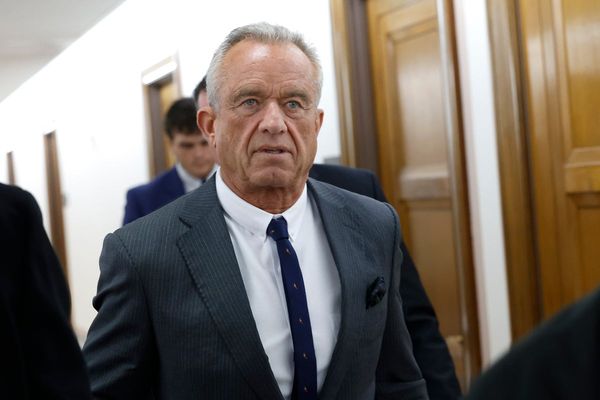
There are some bruising paintings in The Imaginary Institution of India. Rameshwar Broota’s Reconstruction (1977) throbs with bureaucratic horror. Hunched in chairs at the bottom of a vast streaked canvas sit rows of compliant apelike figures – most faceless – with numbers on their chests. Above their heads dangle coloured loops of electric wire. It’s not clear what is happening – or what is about to – but it’s nothing good. The ape-people sit patiently.
Against a night-black sky the tangled, lacerated corpse of activist playwright Safdar Hashmi sprawls from the crook of a tree. His skin waxy and agitated with pink abrasions, his mouth still agape, his eyes hidden by an abstract red slash of paint. Painted by MF Husain in 1989, the year the 34-year-old was murdered during a street theatre performance with his company Janam, it is a painting of undiluted horror.
There is more shocking death, and intimations of it. Gieve Patel’s stylised but inescapably brutal Battered Body in Landscape (1993) offers a corpse disintegrating into its parts and starting to resemble a mottled hillscape. The narrow trench of Sheela Gowda’s Mortar Line (1996) is sculpted in dried cow dung and the gully within it filled with intense red pigment as though the earth itself is bleeding.
The Imaginary Institution of India covers a time of existential crisis in the country’s recent history – the period 1975-1998, bookended by episodes that undermined values of social democracy and non-violence foundational to the post-colonial state. It was a turbulent period scarred by destructive events as well as the multi-generational mass poisoning caused by chemical contamination in Bhopal. For this critic it was an exhibition of discovery (fewer than a third of the 30 names included were familiar to me) – diverse work, much of it powerful.
Within the show’s profoundly serious framework there is scope for delight: in beauty, and familial and romantic love. Bhupen Khakar’s Two Men in Benares (1982) embrace one another, visibly excited. Their towering naked bodies occupy a space blue as evening, beyond which the everyday activities of the holy city of Benares (now Varanasi) continue. The lovers are both of Benares and entirely separate from it, occupying an intimate world of sensation and emotion.
Photos taken by Pablo Bartholomew between 1975-77, during the oppressive years of emergency rule, show students dancing, hanging out and engaged in intense conversation. Life goes on, and young people do what they do, even in times of crisis.
The yellow ochre and plum that flood Nilima Sheikh’s crepuscular triptych Before Nightfall (1981-82) capture a moment of everyday magic – the transition from day to night, in which low buildings, trailing plants, lurking creatures and playing children are washed with golden light. A later work by Sheikh – Shamiana (1996) – provides one of the exhibition’s great moments of theatre. Six double-sided painted panels are arranged in a hinged wooden framework to form a mobile pavilion, with a huge painted canopy suspended above. It could be a temporary space for a celebration, or the backdrop for a travelling theatre. The paintings themselves cycle through aspects of women’s experience, including love and childbirth, all set within a landscape rich with mythic symbolism.
Themes thread through this show’s chronological structure, among them India’s transforming cities, challenges to oppressive class structures, the struggle for women’s and gay rights, and the recognition of and engagement with Indigenous cultures. A leading figure in this last enterprise was artist and critic Jagdish Swaminathan, under whose direction the Bharat Bhavan arts complex in Bhopal championed, exhibited and supported “contemporary folk, tribal and urban art”. Part of the profound interest in Indigenous cultures in this period stemmed from a realisation of all that was imperilled during India’s rapid transformation. Swaminathan’s protégé’s included Jangarh Singh Shyam, whose closely detailed drawings here reinterpret emblems and supernatural entities from the stories of the Pardhan people.
In its very title – borrowed from an essay by Sudipta Kaviraj – The Imaginary Institution of India suggests nation-building as a creative enterprise, one that calls on the lively minds of poets, playwrights, musicians and artists, not just politicians and bureaucrats. The background hum to this show is the activity of artists and intellectuals engaged in political protest, street theatre, and documentation. Engaged, in other words, in continually imagining India, and what it might be.
This impeccably structured show revisits select artists over the course of 23 years. While the penultimate word goes to Nalini Malani, whose multi-screen installation Remembering Toba Tek Singh (1998) marks India’s first nuclear tests, the exhibition closes on a note of gentle optimism. Bhupen Khakhar’s Grey Blanket (1998) revisits the ardent lovers of Two Men in Benares. Seventeen years on, they are white haired, reaching tenderly for one another within a shared blanket, emblems of the endurance of love, above all.
• The Imaginary Institution of India: Art 1975–1998 is at the Barbican, London, until 5 January







